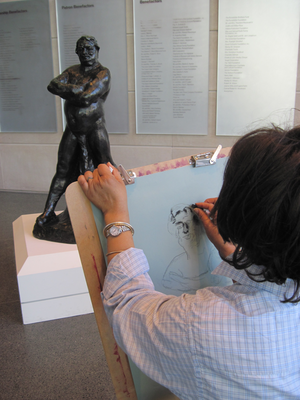It’s important to draw in the Museum
Sculptors and painters draw constantly. Architects, botanists, designers, and many a traveling student have been known to constantly have a sketchbook in hand. But what about teachers? Dancers? Surgeons? What about you?

Join us every third Thursday of the month for drawing in the Museum’s galleries. Each workshop is led by a skilled teaching artist and focuses on a different object from the Museum’s collection, combining conversation with drawing to inspire engagement with art in new ways.
I spent a recent Saturday at an inter-disciplinary conference on drawing. I began the day thinking (as an artist) that I knew what “drawing” meant, and left both more confused and more excited than I had expected. One presenter was a plastic surgeon who thought about what he does with his scalpel as a sort of drawing. He collaborates with a fine artist who follows his hand movements and translates them into marks on paper which become beautiful in a way that only great abstract mark-making is. Another artist made a robot that can draw faces. I’m serious; the robot draws. The drawings are quite good, in fact, leaving out just enough information to convey the hand-drawn (or in this case robot hand-drawn) nature of the work. During the conference a textile artist was knitting responses to research papers about drawing, while a room full of teachers, academics, and artists discussed lines, gestures, marks and media.
I attended this event because we are starting a new evening program at the Museum based around drawing as an artistic and social experience. We’re trying to bring drawing into many different museum experiences in order to explain or record your thoughts and as a way to work though them. We know that drawing helps you see an object differently, but it can help you think differently as well.
Unfortunately, as adults we can sometimes forget to draw. Even for those of us who stick with drawing can forget the joy of it as we spend night after night in our studios, by ourselves. So one night a month we’re hoping to fill one of the Museum’s galleries with people drawing. There will be an instructor who will run though techniques and provide information about artworks, but there will also be you, hopefully lots of you, or people like you, or people unlike you, but people who are all willing to give this experience of looking, talking and drawing a shot. It’s this interaction, this feeling that drawing should be something fun, that will make this program great.
So come join us. And draw something.

Maya Valladares, Gallery/Studio Coordinator, joined the Museum in 2008. She has worked as a studio teacher, a museum educator, a community organizer, and a freelance artist. She holds a BFA from the Rhode Island School of Design and an MA from Hunter College. Her work has been exhibited nationally and internationally, and she is thankful that she works in a museum where new ideas and inspiration never run dry.
